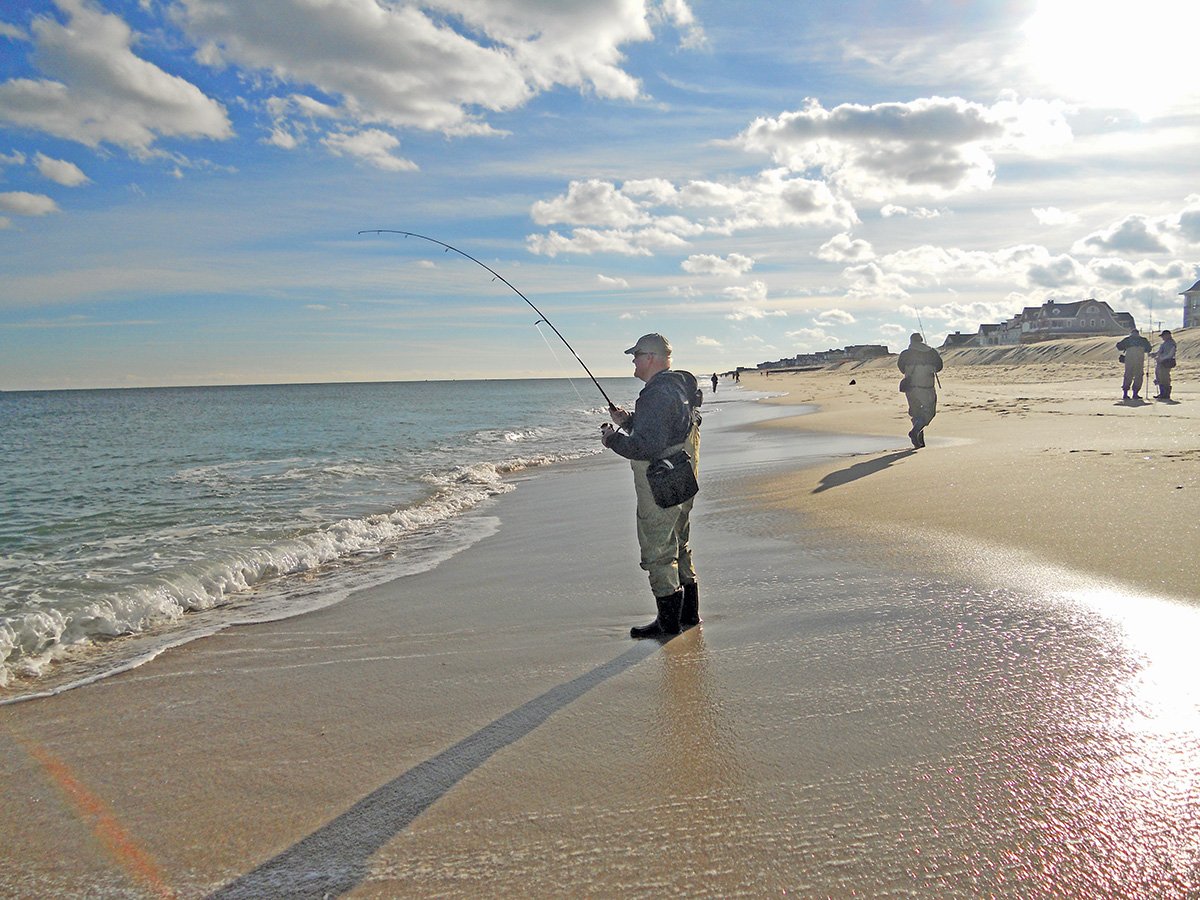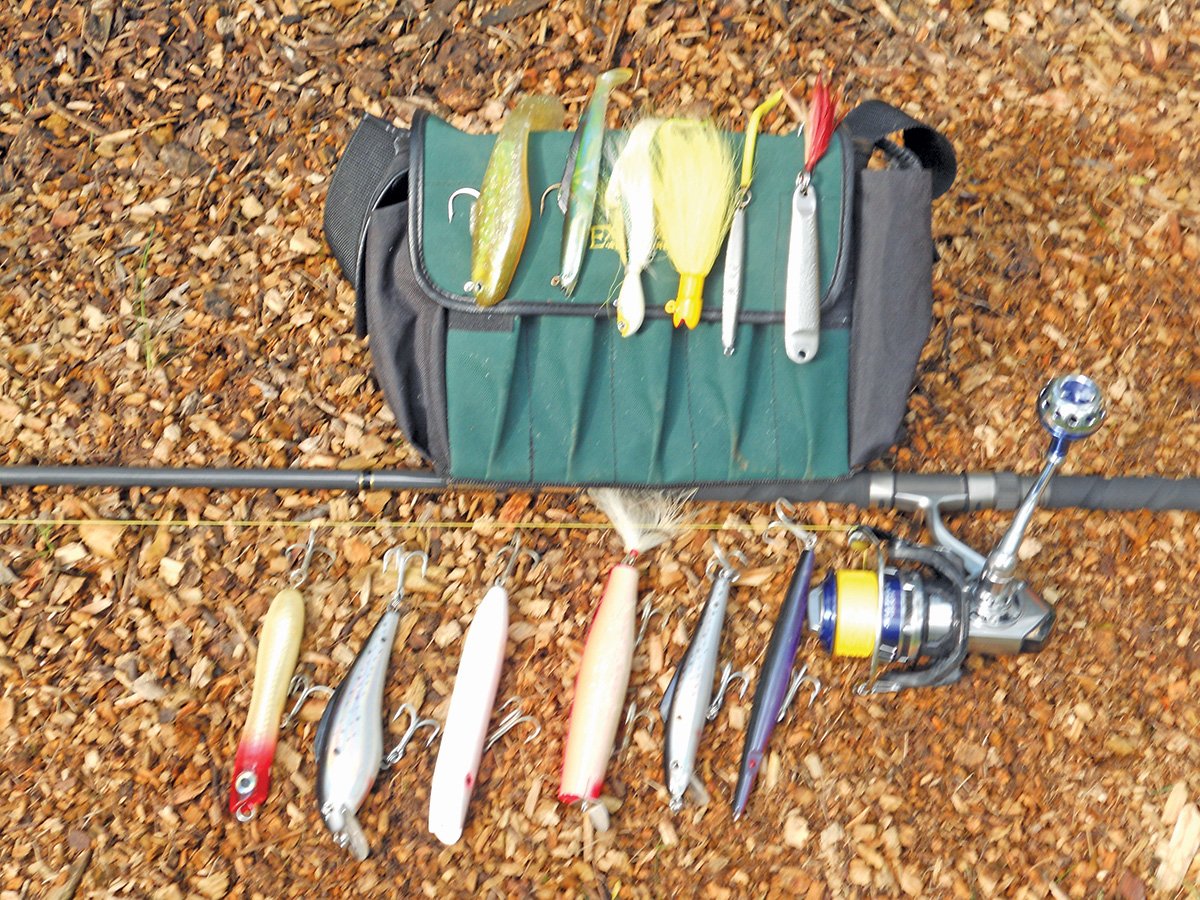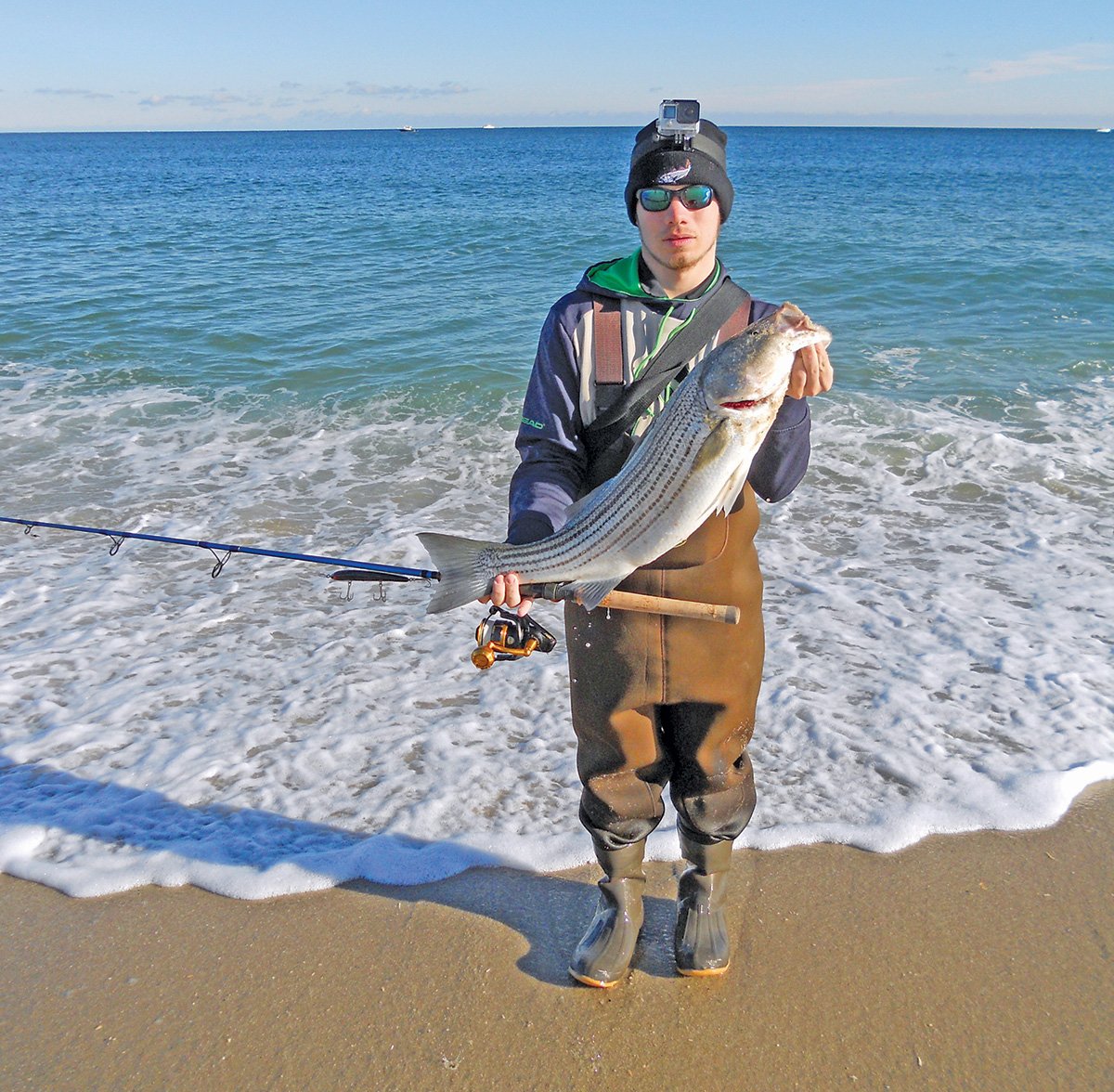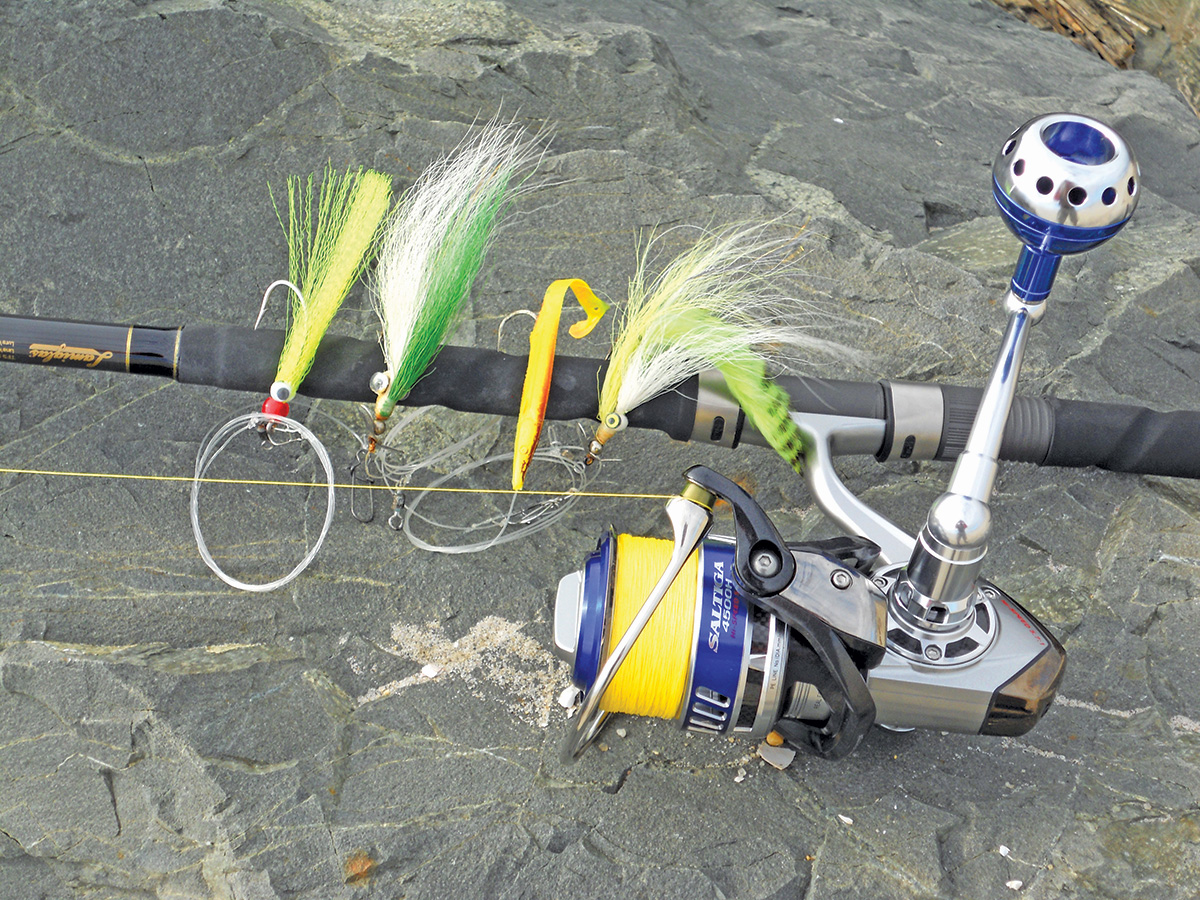
The unofficial end of summer on Labor Day officially kicks open the door to the fall run.
As summer season fades, striped bass and bluefish begin feeding in preparation for their movement south to winter quarters. Simultaneously, huge quantities of forage species that were spawned in Jersey’s rivers and bays vacate their placid homes and venture into the hundred miles of surf. Presto. Where the two groups meet is where you ought to be, as the stripers and blues will be gorging themselves on the huge schools of baby bunker, spearing, mullet, and myriad other forage species that are often swarming just a short cast from the beach.
Knowing just where to be does present a challenge. Towards that end the fishing usually remains consistent so long as the weather does the same. I’ve seen many a season where a flat surf prevailed, with just a few moderately rough days as opposed to a several-day long northeaster that disrupts the fishing, causing the bass and blues to move along. As such, it becomes relatively easy to learn where the fish are congregated and plan your days, or nights, accordingly.
In many of my regular places this season I’ve found the shoreline conditions have drastically changed from prior years. The beach replenishment efforts to correct the damage of prior year storms are underway, resulting in totally new stretches of beach, usually lacking sand bars, holes and gullies of the past. Some beaches now drop off abruptly into deeper water, which I suspect will be moving, as opposed to seeking the protection former beach configurations offered.
As such, it wise for you, as I’ve already begun, to take the time to visit your favorite stretches of beach at low tide with a westerly wind, and you’ll see exactly what awaits you, lacking the ability to wade out to a sandbar at low tide simply because there is no longer a sandbar.
Monitor & Maintain
While my phone often rings off the hook during the height of the run, I must admit that I’m often guided to many a shore location where blitzes are occurring that I may otherwise have missed. But I also regularly check my computer to monitor surf reports of activity as provided by coastal tackle shops, and don’t hesitate to give them a call, where all of them are pleased to give you an up-to-the-minute update.
It is equally important to take time now to switch over from the surf tackle you’ve been using to score with fluke, kingfish and croakers, to a heavier outfit that can accommodate heavier lures and the much heavier adversaries you’re apt to encounter. An 8- to 9-foot long medium weight rod and spinning reel loaded with 15-pound test mono or lighter, thinner 30-pound or so braid is a happy balance that will enable you to handle small lures when there’s a flat surf, yet have the ability and punch to cast a heavy metal squid into the teeth of a stiff northeast wind blowing in your face.
I regularly plan my fall surf excursions by emptying my surf bag and restocking it with a selection of lures that will prove effective in the wide variety of surf conditions that may be encountered. Among my favorites are surface swimming plug and poppers, along with deep running MirrOlures. Block tin squids and pork rind are a must, as are vintage Hopkins NoEqls for those days when there’s a nasty heave from offshore. I always have some bucktail jigs for those days when I visit inlets to fish an ebbing tide of its clear river waters, as the storm waters having made the surf water dirty and unfishable.
There’s also a packet of a half dozen or so bucktail and feather teasers, as quite honestly in recent years I’ve caught more fish on the teasers that swim ahead of a primary lure than the lure intended for larger fish. While I’m primarily targeting blues and bass, the teaser surprises me by producing occasional hickory shad, herring, bonito, false albacore and weakfish. I’ve even caught a red drum on a teaser.

I’ll also include several pre-tied leaders that can accommodate a primary lure with a teaser 30 to 36 inches ahead of it. I also include a couple of stainless steel wire leaders for those occasions when blues predominate, as I’ve experienced too many abrupt cutoffs when a husky blue literally bites through a mono leader as it is thrashing on the surface.
While I prefer probing the surf with lures during the fall I’m not reluctant to switch to bottom fishing with clams, moss bunker chunks or soft shell crabs when a rough, but clean surf warrants. A handful of rigs, along with pyramid sinkers are in the side pocket of the surf bag just in case they’re needed.
Suffice to say a tape measure, pliers, knife, snap swivels and a headlamp with fresh batteries to wear around your neck after dark are also to be included.
| THE BIG TEASE |
|---|
|
Small plastics, feathers, bucktails, flies or stingers, those smaller lead presentations often get a good look from stripers and blues in tight to the beach, which is also why reeling until your rig is at your feet is always important. “I can’t overly emphasize the importance of always lowering your rod tip gradually as you retrieve any of your lures and teasers, so that they literally swim right onto the beach,” the author said. |
Lighten Your Load
Wearing a collection of terminal tackle, lures and equipment in a bag around your neck will wear you out more than actually casting from the beach. Many mistakenly use this approach and quickly poop out. As such I’m prone to leave the bag full of gear in the trunk of the car, removing those lures and rigs that appear appropriate for the wind, tide and surf conditions that I encounter and placing them in my jacket’s large pockets, which gives me flexibility. It permits me to walk a mile or more of beach, casting as I go, with minimum heavy impairment of a surf bag full of gear that I may never use that day. Better to use just a couple of lures that work with existing conditions and you’ll be more readily rewarded.
Suffice to say that when you pull up to the end of the street where it meets your favorite section of beach it may look entirely different than it did a year ago. Having studied its configuration, just move forward with enthusiasm by selecting a lure that’s appropriate for conditions. While I have favorite lures for each condition, I don’t hesitate to change periodically, hopefully scoring as a bonus.
Oftentimes I’ve walked over the dunes and much to my delight saw the air alive with gulls circling, then diving into the churning surf, moments later becoming airborne again with a tasty baby bunker in their jaws. It’s an exciting moment and almost a guarantee of a fun day’s fishing. But don’t always expect this. Often I’ve seen not a single gull, but a barren stretch of surf that required I meticulously probe the waters.

My favorite results often occur when I observe tightly packed pockets of baitfish a mere rod’s length from the sand, lifting up with a wave as it heads to the beach, and then receding with them as it heads seaward again. Those baitfish are usually nervous, seeking the little sanctuary offered in the thin sliver of water between the sand and the drop-off to deep water caused by many of the beach replenishment projects along the Jersey Shore.
Towards this end, I cannot emphasize enough that the focus should not always be to make long-distance casts, and after having retrieved 75% of a cast to hurriedly reel in the remainder to make another cast. While occasionally the long cast will bring results when schools of bait are offshore, for the most part the bait is tight to the beach. As such, it becomes extremely important to continue your retrieve right up to the time the lure tumbles onto the sand. You’ll often be pleasantly surprised and have your rod and reel practically ripped from your hand as a big blue or lunker striper grabs your lure just a rod’s length or two from where you’re standing.
 The author is a huge proponent of teasers during the fall run and has enjoyed increased success from this “bonus” hook, most often with smaller fish, lower than the size limit in the case of stripers, but a blast all the same. “It’s important, however, that you promptly and cautiously remove the teaser and quickly release the striper to the water, enabling it to return to its chore of searching for a meal, and perhaps returning next season as a keeper,” he added.
The author is a huge proponent of teasers during the fall run and has enjoyed increased success from this “bonus” hook, most often with smaller fish, lower than the size limit in the case of stripers, but a blast all the same. “It’s important, however, that you promptly and cautiously remove the teaser and quickly release the striper to the water, enabling it to return to its chore of searching for a meal, and perhaps returning next season as a keeper,” he added.


